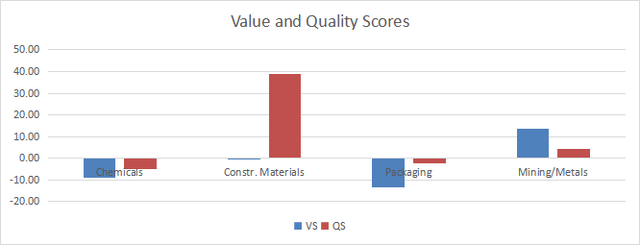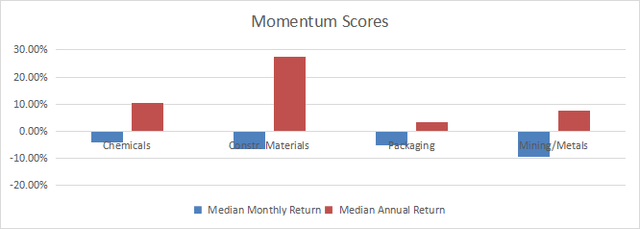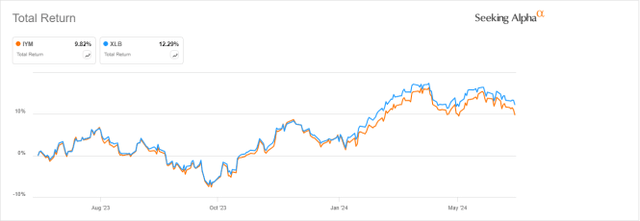Opla
This monthly article series shows a dashboard with aggregate industry metrics in materials. It is also a review of sector ETFs like the Materials Select Sector SPDR ETF (XLB) and iShares U.S. Basic Materials ETF (NYSEARCA:IYM), whose largest holdings are used to calculate these metrics.
Shortcut
The next two paragraphs in italic describe the dashboard methodology. They are necessary for new readers to understand the metrics. If you are used to this series or if you are short of time, you can skip them and go to the charts.
Base Metrics
I calculate the median value of five fundamental ratios for each industry: Earnings Yield (“EY”), Sales Yield (“SY”), Free Cash Flow Yield (“FY”), Return on Equity (“ROE”), Gross Margin (“GM”). The reference universe includes large companies in the U.S. stock market. The five base metrics are calculated on trailing 12 months. For all of them, higher is better. EY, SY and FY are medians of the inverse of Price/Earnings, Price/Sales and Price/Free Cash Flow. They are better for statistical studies than price-to-something ratios, which are unusable or non-available when the “something” is close to zero or negative (for example, companies with negative earnings). I also look at two momentum metrics for each group: the median monthly return (RetM) and the median annual return (RetY).
I prefer medians to averages because a median splits a set in a good half and a bad half. A capital-weighted average is skewed by extreme values and the largest companies. My metrics are designed for stock-picking rather than index investing.
Value and Quality Scores
I calculate historical baselines for all metrics. They are noted respectively EYh, SYh, FYh, ROEh, GMh, and they are calculated as the averages on a look-back period of 11 years. For example, the value of EYh for packaging in the table below is the 11-year average of the median Earnings Yield in packaging companies.
The Value Score (“VS”) is defined as the average difference in % between the three valuation ratios (EY, SY, FY) and their baselines (EYh, SYh, FYh). The same way, the Quality Score (“QS”) is the average difference between the two quality ratios (ROE, GM) and their baselines (ROEh, GMh).
The scores are in percentage points. VS may be interpreted as the percentage of undervaluation or overvaluation relative to the baseline (positive is good, negative is bad). This interpretation must be taken with caution: the baseline is an arbitrary reference, not a supposed fair value. The formula assumes that the three valuation metrics are of equal importance.
Current data
The next table shows the metrics and scores as of writing. Columns stand for all the data named and defined above.
|
VS |
QS |
EY |
SY |
FY |
ROE |
GM |
EYh |
SYh |
FYh |
ROEh |
GMh |
RetM |
RetY |
|
|
Chemicals |
-8.76 |
-5.06 |
0.0311 |
0.5132 |
0.0170 |
16.22 |
41.95 |
0.0422 |
0.4478 |
0.0199 |
17.85 |
42.38 |
-4.18% |
10.51% |
|
Constr. Materials |
-0.57 |
38.83 |
0.0469 |
0.6204 |
0.0404 |
21.25 |
36.29 |
0.0408 |
0.7940 |
0.0384 |
13.55 |
30.06 |
-6.41% |
27.37% |
|
Packaging |
-13.24 |
-2.18 |
0.0429 |
1.1119 |
0.0237 |
16.88 |
26.29 |
0.0491 |
1.0384 |
0.0360 |
18.47 |
25.21 |
-5.14% |
3.28% |
|
Mining/Metals |
13.47 |
4.13 |
0.0475 |
0.8721 |
0.0384 |
9.25 |
23.32 |
0.0420 |
1.1544 |
0.0253 |
9.42 |
21.20 |
-9.51% |
7.64% |
Value and Quality chart
The next chart plots the Value and Quality Scores by industry (higher is better).
Value and quality in materials (Chart: author; data: Portfolio123)
Evolution since last month
The value score has improved, except in packaging.
Score variations (Chart: author; data: Portfolio123)
Momentum
The next chart plots momentum scores based on median returns.
Momentum in Materials (Chart: author; data: Portfolio123)
Interpretation
The basic materials sector was moderately overvalued relative to 11-year averages in my latest S&P 500 dashboard. As of writing, the mining and metals industry is undervalued by about 13%, though. The construction materials industry is close to its historical baseline in value, and significantly above it in quality. Packaging and chemicals are slightly overvalued and close to their quality baseline.
Fast facts on IYM
iShares U.S. Basic Materials ETF started investing operations on 6/12/2000 and tracks the Russell 1000 Basic Materials RIC 22.5/45 Capped Index. Its total expense ratio is higher than for XLB: 0.40% vs.0.09%.
IYM holds 39 stocks and it is very concentrated. The top 10 companies, listed in the next table, represent 65.2% of asset value and the top name, Linde, weighs 20.3%. Nevertheless, XLB is not better regarding diversification, with over 66.7% of assets in the top 10 holdings and 21.1% in Linde.
|
Ticker |
Name |
Weight |
EPS growth %TTM |
P/E TTM |
P/E fwd |
Yield% |
|
Linde plc |
20.30 |
43.18 |
33.90 |
28.20 |
1.27 |
|
|
Freeport-McMoRan Inc. |
7.47 |
-36.46 |
42.29 |
29.24 |
1.25 |
|
|
Air Products and Chemicals, Inc. |
6.90 |
13.66 |
24.89 |
22.43 |
2.57 |
|
|
Ecolab Inc. |
6.52 |
34.09 |
44.43 |
36.39 |
0.95 |
|
|
Newmont Corp. |
5.05 |
-304.13 |
N/A |
16.16 |
2.45 |
|
|
Nucor Corp. |
4.26 |
-33.39 |
9.10 |
13.49 |
1.40 |
|
|
Dow Inc. |
4.22 |
-58.10 |
32.82 |
18.23 |
5.09 |
|
|
Fastenal Co. |
3.84 |
4.25 |
31.23 |
30.48 |
2.47 |
|
|
International Flavors & Fragrances Inc. |
3.51 |
-19.22 |
N/A |
23.79 |
1.69 |
|
|
LyondellBasell Industries N.V. |
3.15 |
-29.91 |
14.46 |
11.25 |
5.73 |
Since 7/1/2000, IYM has underperformed XLB by 71 bps in annualized return, as reported in the next table. It also shows a higher risk measured in drawdown and volatility (measured as standard deviation of monthly returns).
|
Total return |
Annualized return |
Max Drawdown |
Sharpe ratio |
Volatility |
|
|
IYM |
535.23% |
8.02% |
-67.78% |
0.39 |
22.69% |
|
XLB |
641.99% |
8.73% |
-59.83% |
0.44 |
20.50% |
IYM is lagging by about 2.5% over the last 12 months:
IYM vs. XLB, 12-month return (Seeking Alpha)
In summary, IYM offers a capital-weighted exposure to basic materials companies of the Russell 1000 index. It is invested in 39 large and mid-cap stocks, whereas XLB holds 28 large companies. IYM has a capped weighting methodology to avoid excessive concentration in the top holdings (maximum of 22.5% by company, and 45% aggregate in companies weighting more than 4.5%). However, XLB looks more attractive based on management fee, liquidity, historical return and volatility. Investors willing to avoid the risks related to the top holding of capital-weighted materials funds may prefer Invesco S&P 500® Equal Weight Materials ETF (RSPM).
Dashboard List
I use the first table to calculate value and quality scores. It may also be used in a stock-picking process to check how companies stand among their peers. For example, the EY column tells us that a chemical company with an Earnings Yield above 0.0311 (or price/earnings below 32.15) is in the better half of the industry regarding this metric. A Dashboard List is sent every month with the most profitable companies standing in the better half among their peers regarding the three valuation metrics at the same time. For example, the stocks below are part of the list sent a few weeks ago.
|
Celanese Corp. |
|
|
Apogee Enterprises, Inc. |
|
|
Builders FirstSource, Inc. |
|
|
Griffon Corp. |
|
|
Owens Corning |
It is part of a rotational model with a statistical bias toward excess returns on the long-term, not the result of in-depth stock analysis.



